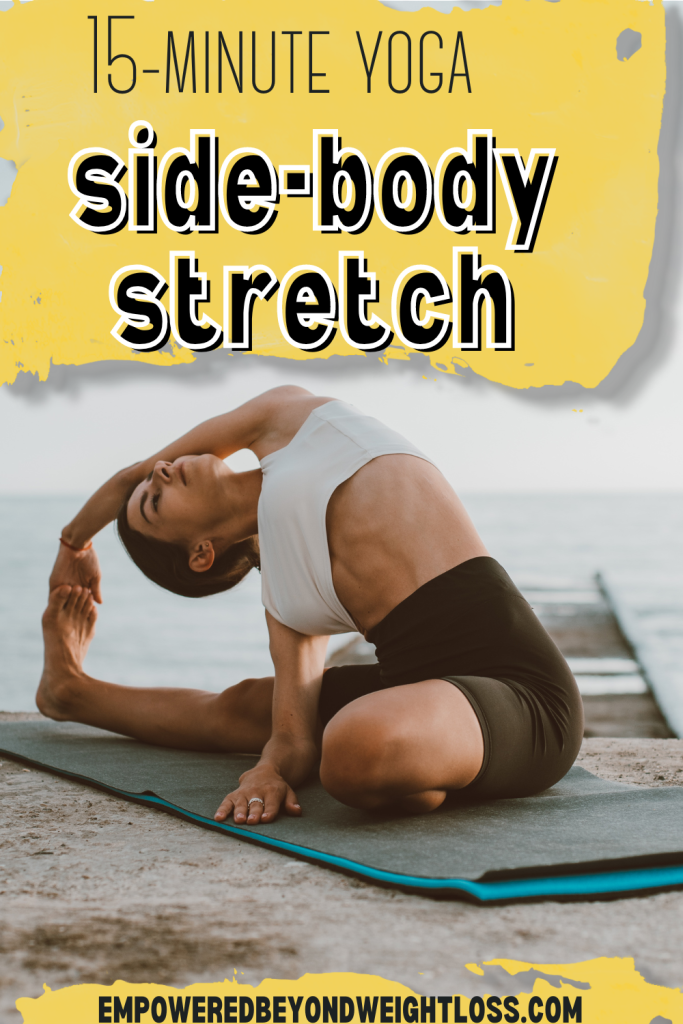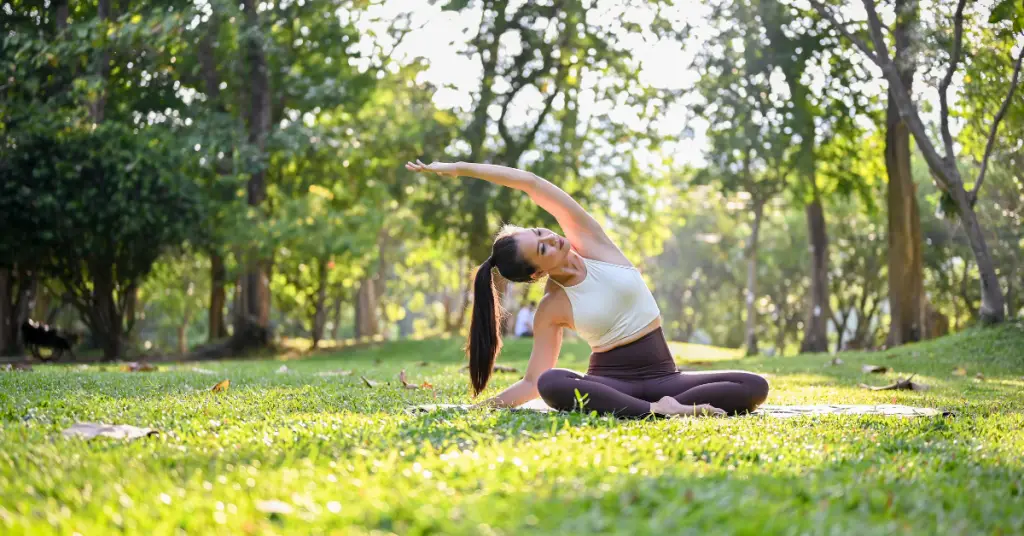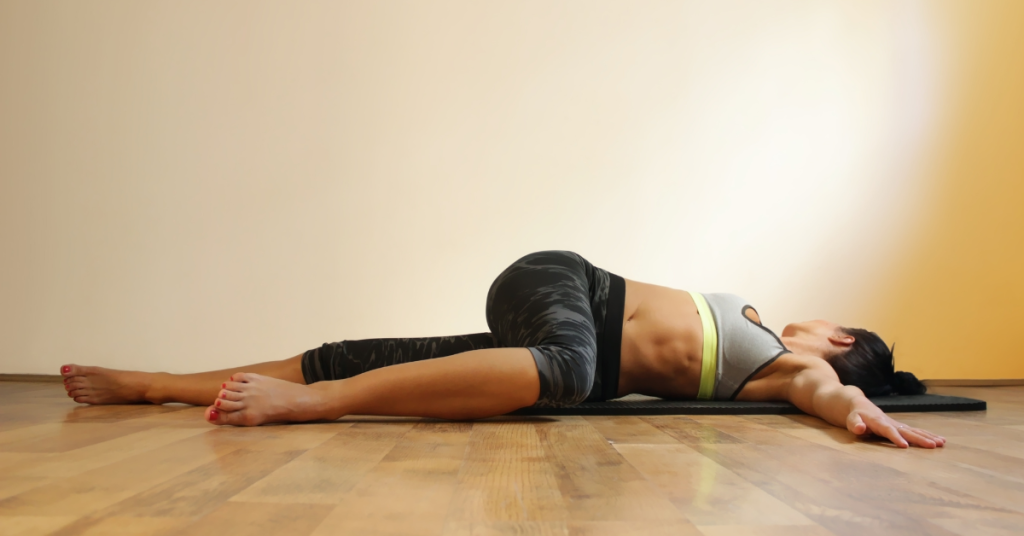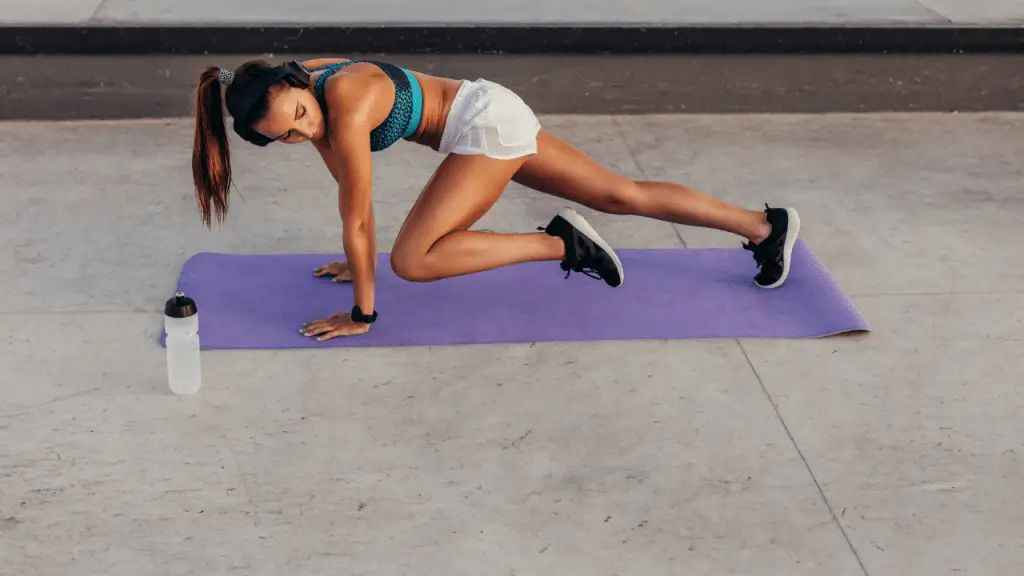I am excited about this yoga side-body stretch routine because I will use it myself. If you are familiar with my content and programs, you may have noticed that I tend to focus on leg and back flexibility. These areas are key when working on poses like the splits and the king pigeon, which are some of my favorite poses to work toward when getting started with yoga. After three years, I now notice the need to increase my side body flexibility. Check out my 1-Year Yoga Transformation to learn more about my yoga journey.
15-Minute Yoga Side-Body Stretch Routine
So far, I have been working on my side body flexibility as part of some of my favorite vinyasa flows. I wanted something more, and that’s what I created today.
Today’s yoga side-body stretch takes you through some of my favorite side-bending poses, and we stay there just long enough.
Yoga Side-Body Stretches
These are the stretches you will find in today’s 15-minute yoga side stretch routine:
Double Knee Supine Twist:
- Begin by lying on your back with your legs extended straight.
- Bend both knees and draw them toward your chest.
- Exhale as you gently guide both knees to one side, either to the left or right, while keeping your shoulders grounded on the mat.
- Extend your arms out to the sides, creating a “T” shape with your body, palms facing down.
- Turn your head in the opposite direction of your knees, gazing toward your outstretched hand on that side.
- Relax into the twist and take deep, slow breaths. Feel the stretch along your spine and in your lower back.
- Hold the pose for about 30 seconds to 1 minute.
- To release, inhale as you bring your knees back to the center and then extend your legs straight.
- Repeat the twist on the other side by bending both knees and guiding them to the opposite side.
The Double Knee Supine Twist is a gentle and effective way to stretch the spine, lower back, and hip area. It can help release tension and improve flexibility in the back and torso. This twist is often used for relaxation and as a part of a cool-down in a yoga practice.

Revolved Half Splits (Parivrtta Ardha Hanumanasana):
- Begin in a kneeling position with your knees directly under your hips.
- Extend your right leg straight out in front of you, flexing your right foot.
- Inhale to lengthen your spine, and as you exhale, hinge at your hips to fold forward over your extended right leg.
- Place both hands on the floor on either side of your right leg, using yoga blocks if needed for support.
- Inhale deeply to create length in your spine.
- Exhale and twist your torso to the right, reaching your left hand to the inside of your right ankle.
- Extend your right arm upward, reaching it toward the sky.
- Keep your chest open and gaze up toward your right hand or forward, depending on your comfort.
- Feel the stretch along your right hamstring, and notice the engagement of your obliques and spinal muscles due to the twist.
- Hold the pose for about 1 minute, maintaining steady and deep breaths.
- To release, inhale and gently untwist your torso, returning to Half Monkey Pose.
- Repeat the pose on the other side by extending your left leg and twisting to the left.

Revolved Forward Fold Pose (Parivrtta Uttanasana):
- Start in a standing position with your feet hip-width apart and your arms at your sides.
- Inhale deeply to lengthen your spine and create space between your vertebrae.
- As you exhale, hinge at your hips to fold forward at the waist, bringing your torso toward your thighs.
- Keep your knees slightly bent to avoid excessive strain on the lower back, especially if you’re less flexible.
- Place your hands on the floor or yoga blocks beside your feet. If you can’t reach the floor comfortably, bend your knees more or use props.
- Inhale again to create length in your spine.
- Exhale as you begin to twist your torso to the right. Place your right hand on the floor or a block in line with your right foot.
- Extend your left arm upward, opening your chest toward the left side (use a bind assist if that feels good).
- Keep your gaze up at your left hand or forward, depending on your neck comfort.
- Feel the stretch along the back of your legs, especially in the hamstrings and calves, as well as the twist through your torso.
- Hold the pose for about 30 seconds to 1 minute, maintaining steady breaths.
- Inhale to release the twist, returning to the forward fold position.
- Exhale and repeat the twist on the other side by placing your left hand on the floor or block in line with your left foot and extending your right arm upward.
We will continue with the Triangle and Extended Side Angle poses included in the 5-minute standing routine below and close with the Revolved Head-to-Knee pose and Half Lord of the Fishes Pose) (both in the 5-minute seated sequence below).

Yoga Side Body Stretch Benefits
Yoga side body stretches offer a wide range of benefits for your physical, mental, and emotional well-being. Incorporating these stretches into your yoga practice can improve flexibility, posture, and overall health. Here are some of the key benefits of doing yoga side body stretches:
- Increased Flexibility: Side body stretches involve lengthening and stretching the muscles along the sides of your torso, including the obliques and intercostal muscles. Regular practice can help increase your overall flexibility, making moving and performing daily activities easier.
- Improved Posture: Many people suffer from poor posture due to long hours of sitting or other lifestyle factors. Yoga side body stretches can help open up the chest and shoulders, allowing you to stand taller and align your spine correctly. This improved posture can relieve back and neck pain and reduce the risk of musculoskeletal issues.
- Enhanced Lung Capacity: These stretches involve deep breathing and expansion of the ribcage, which can enhance your lung capacity. Improved respiratory function benefits your yoga practice and promotes better oxygen circulation throughout the body, leading to increased energy levels and reduced stress.
- Stress Reduction: Combining deep, mindful breathing and releasing tension in the side body can calm the nervous system. This can help reduce stress and anxiety levels, leaving you feeling more relaxed and centered.
- Digestive Health: Side body stretches can stimulate the abdominal organs, including the digestive organs like the liver, kidneys, and spleen. Regular practice can aid in digestion and help alleviate common digestive issues like bloating and constipation.
- Balanced Energy Flow: In yoga philosophy, it’s believed that energy, or prana, flows through channels called nadis. Side body stretches can help balance the energy flow through the Ida and Pingala nadis, promoting a sense of equilibrium and vitality.
- Enhanced Circulation: These stretches improve blood circulation throughout the body, especially in the abdominal and pelvic regions. Improved circulation can positively impact organ function, skin health, and overall vitality.
- Better Body Awareness: Exercising side body stretches encourages greater awareness and mindfulness. As you focus on the sensations in your side body, you become more attuned to your body’s needs and can make healthier choices in terms of movement, posture, and lifestyle.
- Pain Relief: People experiencing chronic pain, especially in the lower back or hips, may find relief through regular side-body stretching. The gentle, controlled movements can help alleviate tension and discomfort in these areas.
- Enhanced Athletic Performance: For athletes and fitness enthusiasts, improved flexibility and posture gained from side-body stretches can lead to better performance in various sports and physical activities. These stretches can also help prevent injuries by promoting a better range of motion.
Incorporating yoga side body stretches into your routine, whether as part of a dedicated yoga practice or as a warm-up/cool-down for other activities, can provide numerous physical and mental benefits.
Struggling with staying consistent? Consider joining my 5-Day Yoga Habit Challenge. You will get daily 5-minute workout routines and habit mini-coaching sessions so that you can finally feel energized, strong, and flexible.
Standing Side Body Stretches
Since I often recommend 5-minute stretches for those days when you feel like you have no time but still want to get on your mat to create your yoga habit, I also have two short 5-minute side body stretches for you: one standing and one seated.
This routine will help you improve flexibility, posture, and overall well-being:
1. Mountain Pose (Tadasana)
- Start by standing tall with your feet hip-width apart and your arms at your sides.
- Lengthen your spine, engage your core, and relax your shoulders.
- Take deep breaths and focus on grounding yourself, then inhale, lift your arms to the sky, since your left side to stretch the right.
- Hold for 30 seconds, then switch sides.
2. Triangle Pose (Trikonasana)
- Step your feet wide apart, about 3-4 feet.
- Turn your right foot out 90 degrees and your left foot in slightly.
- Extend your arms out to the sides at shoulder height.
- Inhale deeply, and as you exhale, reach your right hand toward your right ankle while keeping your left arm extended upward.
- Keep your chest open and gaze up at your left hand.
- Hold for one minute, then switch sides.
3. Extended Side Angle Pose (Utthita Parsvakonasanaa)
- Bend your right knee deeply, keeping it in line with your ankle.
- Place your right forearm on your right thigh or the floor inside your right foot.
- Extend your left arm overhead, creating a straight line from your left heel to your fingertips.
- Hold for one minute, then switch sides.
Seated Side Body Stretches
Here’s a 5-minute seated side body stretch routine that you can follow. Most stretches will be held for one minute. This routine is great for increasing flexibility and relieving tension in the side body while seated.
1. Seated Side Bend Pose (Parsva Sukhasana)
- Keep your legs extended wide apart.
- Inhale as you reach your arms up overhead.
- Exhale and lower your right hand toward your right foot while extending your left arm overhead.
- Hold for 30 seconds, feeling the stretch along the left side of your body.
- Inhale to come back up, and then switch sides.
2. Seated Twist (Marichyasana)
- Bend your right knee and place your right foot on the mat close to your body.
- Inhale to lengthen your spine, and twist your torso to the right as you exhale.
- Hold your right knee with your left hand and place your right hand behind you for support.
- Hold the twist for one minute, then switch sides.
3. Revolved Head-to-Knee Pose (Parivrtta Janu Sirsasana):
- Begin seated with both legs extended straight in front of you.
- Bend your right knee and place the sole of your right foot against the inside of your left thigh.
- Inhale, lengthening your spine, and sitting up tall.
- Exhale and twist your torso to the left, bringing your chest closer to your left thigh.
- Reach your left hand toward the outside of your right knee or shin, or even place it on the outside of your right foot, depending on your flexibility.
- Extend your right arm overhead, then reach it forward toward your left foot. If possible, hold your left foot or ankle.
- Keep your spine long as you deepen the twist to the left, feeling the stretch along the entire left side of your body.
- Turn your head to gaze over your left shoulder or toward the ceiling, depending on what’s comfortable for your neck.
- Maintain the pose, focusing on deep and steady breaths, for about 30 seconds to 1 minute.
- Inhale to release the twist and return to a centered position with both legs extended.
- Repeat the pose on the other side by bending your left knee and twisting to the right.
4. Return to Comfortable Seated Position
- After completing the twists, return to a comfortable seated position, cross-legged or with your legs extended.
- Close your eyes and take a few deep breaths to center yourself.




